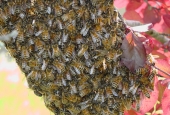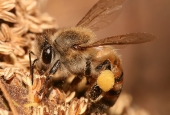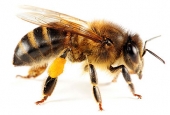Honeybees measure about 3/5” long and are light yellow/brown in color. They are usually oval-shaped creatures with golden-yellow colors and black/brown bands covered with thick masses of hair.
Honey bees are highly active and industrious insects. They pollinate plants and produce honey to sustain their hives through the cooler seasons when flowers are less abundant. Hives are started by a queen who hibernates over the winter. In the spring she produces the eggs which become worker bees that are needed to enlarge the hive, bring in food, and raise the young. A hive can grow to relatively large numbers of individuals. Nests that are several years old will sometimes have hundreds or thousands of bees.
Occasionally wild honey bees will establish their hive in close proximity to human homes or work places. In these cases, the honey bee can become a problem as they will send out large numbers of bees to protect the nest when disturbed. The stings can be very painful and some individuals can react allergically and require medical attention. Honey bee stingers are barbed: when they sting the honeybee cannot pull the stinger back out. It leaves behind not only the stinger, but also a venom sac which continues to pulse venom into the victim.
During summer months, a bee hive may become too successful and the queen senses a future overpopulation problem. She will lay eggs for new queens. A day or so before they emerge, the queen signals about half the worker bees and they leave the old hive in a large cluster, a swarm. They congregate in a mass on a tree branch or other support a few blocks from the original hive. Scout bees are then sent out in search of a new, suitable hive location. When a good location is found (usually within three days) the insects leave in a group (a few stragglers may be left behind). Honey bees are much less aggressive in a swarm. They have no honey or young to defend and are simply looking for a new home. Often, honey bees swarm can be removed, maintained and kept productive by local beekeepers. Bee keepers are anxious to remove swarms in the early part of the year. They may charge a fee for removal.
Sometimes it is necessary to destroy a troublesome hive due to public health concerns. If you have a hive that you believe needs to be treated and destroyed, please contact the District and make a request for services. PLEASE NOTE: Insects inside buildings (walls, attics or foundations) are not serviced by the District and you are advised to call a beekeeper or professional pest management company.
Download the complete Brochure here






